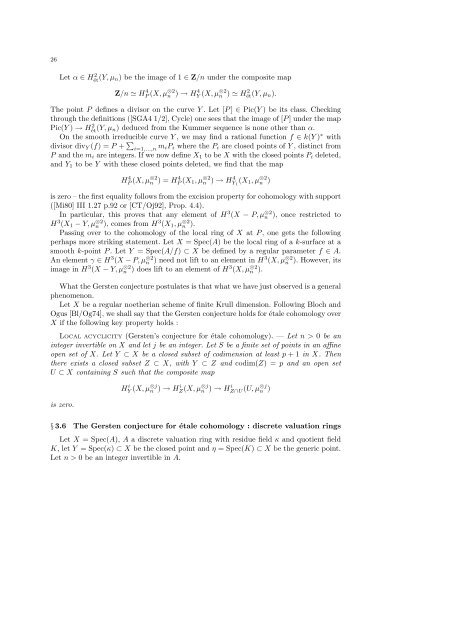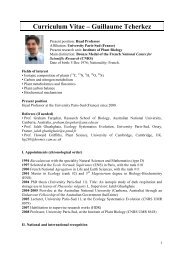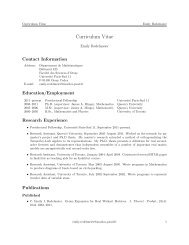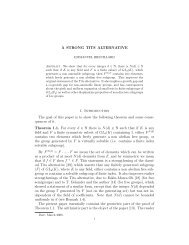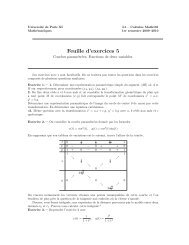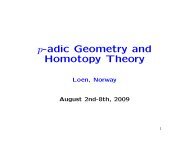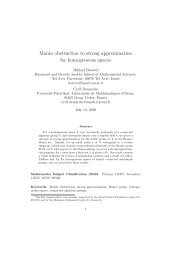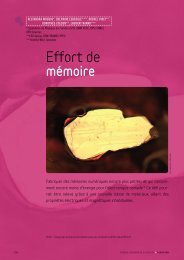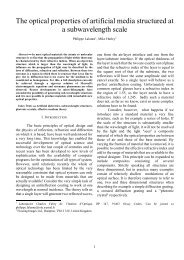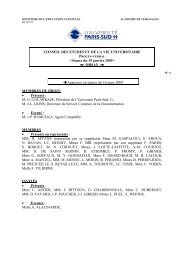Birational invariants, purity and the Gersten conjecture Lectures at ...
Birational invariants, purity and the Gersten conjecture Lectures at ...
Birational invariants, purity and the Gersten conjecture Lectures at ...
Create successful ePaper yourself
Turn your PDF publications into a flip-book with our unique Google optimized e-Paper software.
26<br />
Let α ∈ H 2 ét (Y, µ n) be <strong>the</strong> image of 1 ∈ Z/n under <strong>the</strong> composite map<br />
Z/n ≃ HP 4 (X, µ ⊗2<br />
n ) → HY 4 (X, µ ⊗2<br />
n ) ≃ Hét(Y, 2 µ n ).<br />
The point P defines a divisor on <strong>the</strong> curve Y . Let [P ] ∈ Pic(Y ) be its class. Checking<br />
through <strong>the</strong> definitions ([SGA4 1/2], Cycle) one sees th<strong>at</strong> <strong>the</strong> image of [P ] under <strong>the</strong> map<br />
Pic(Y ) → H 2 ét (Y, µ n) deduced from <strong>the</strong> Kummer sequence is none o<strong>the</strong>r than α.<br />
On <strong>the</strong> smooth irreducible curve Y , we may find a r<strong>at</strong>ional function f ∈ k(Y ) ∗ with<br />
divisor div Y (f) = P + ∑ i=1,...,n m iP i where <strong>the</strong> P i are closed points of Y , distinct from<br />
P <strong>and</strong> <strong>the</strong> m i are integers. If we now define X 1 to be X with <strong>the</strong> closed points P i deleted,<br />
<strong>and</strong> Y 1 to be Y with <strong>the</strong>se closed points deleted, we find th<strong>at</strong> <strong>the</strong> map<br />
H 4 P (X, µ ⊗2<br />
n<br />
) = HP 4 (X 1 , µ ⊗2<br />
n ) → HY 4 1<br />
(X 1 , µ ⊗2<br />
n )<br />
is zero – <strong>the</strong> first equality follows from <strong>the</strong> excision property for cohomology with support<br />
([Mi80] III 1.27 p.92 or [CT/Oj92], Prop. 4.4).<br />
In particular, this proves th<strong>at</strong> any element of H 3 (X − P, µ ⊗2<br />
n ), once restricted to<br />
H 3 (X 1 − Y, µ ⊗2<br />
n ), comes from H 3 (X 1 , µ ⊗2<br />
n ).<br />
Passing over to <strong>the</strong> cohomology of <strong>the</strong> local ring of X <strong>at</strong> P , one gets <strong>the</strong> following<br />
perhaps more striking st<strong>at</strong>ement. Let X = Spec(A) be <strong>the</strong> local ring of a k-surface <strong>at</strong> a<br />
smooth k-point P . Let Y = Spec(A/f) ⊂ X be defined by a regular parameter f ∈ A.<br />
An element γ ∈ H 3 (X − P, µ ⊗2<br />
n ) need not lift to an element in H 3 (X, µ ⊗2<br />
n ). However, its<br />
image in H 3 (X − Y, µ ⊗2<br />
n ) does lift to an element of H 3 (X, µ ⊗2<br />
n ).<br />
Wh<strong>at</strong> <strong>the</strong> <strong>Gersten</strong> <strong>conjecture</strong> postul<strong>at</strong>es is th<strong>at</strong> wh<strong>at</strong> we have just observed is a general<br />
phenomenon.<br />
Let X be a regular noe<strong>the</strong>rian scheme of finite Krull dimension. Following Bloch <strong>and</strong><br />
Ogus [Bl/Og74], we shall say th<strong>at</strong> <strong>the</strong> <strong>Gersten</strong> <strong>conjecture</strong> holds for étale cohomology over<br />
X if <strong>the</strong> following key property holds :<br />
LOCAL ACYCLICITY (<strong>Gersten</strong>’s <strong>conjecture</strong> for étale cohomology). — Let n > 0 be an<br />
integer invertible on X <strong>and</strong> let j be an integer. Let S be a finite set of points in an affine<br />
open set of X. Let Y ⊂ X be a closed subset of codimension <strong>at</strong> least p + 1 in X. Then<br />
<strong>the</strong>re exists a closed subset Z ⊂ X, with Y ⊂ Z <strong>and</strong> codim(Z) = p <strong>and</strong> an open set<br />
U ⊂ X containing S such th<strong>at</strong> <strong>the</strong> composite map<br />
is zero.<br />
H i Y (X, µ ⊗j<br />
n<br />
) → HZ(X, i µ ⊗j<br />
n ) → HZ∩U i (U, µ ⊗j<br />
n )<br />
§ 3.6 The <strong>Gersten</strong> <strong>conjecture</strong> for étale cohomology : discrete valu<strong>at</strong>ion rings<br />
Let X = Spec(A), A a discrete valu<strong>at</strong>ion ring with residue field κ <strong>and</strong> quotient field<br />
K, let Y = Spec(κ) ⊂ X be <strong>the</strong> closed point <strong>and</strong> η = Spec(K) ⊂ X be <strong>the</strong> generic point.<br />
Let n > 0 be an integer invertible in A.


